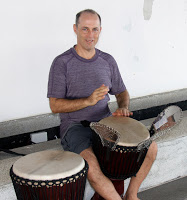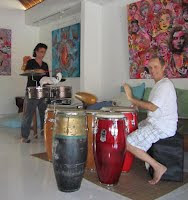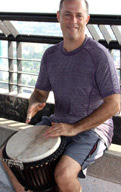The Difference Between Djembe And Conga
This post is part of the Michael Pluznick author residency at X8Drums.com. Enjoy!
When I first started drumming in the early-70's the djembe was a relatively unknown instrument. I had learned conga drumming in Boston but started djembe and West African studies in California in 1979 with the late Craig 'Simbo' Anderson. An accomplished drummer in several styles, including West African and Afro-Cuban, he was instrumental in encouraging me to learn and play in both styles. I studied in Cuba in 1985 and 1995 and in Mali in 2005 and 2007 as well.
I don't have a favorite drum or style. As I will explain, I love them both for different reasons.
The djembe has gained worldwide popularity in the last fifteen years, especially with the phenomenon of drum circles and proliferation of traditional West African music, teachers, classes and events. However, the conga remains ubiquitous for many practical and artistic reasons, too.
Friends and students often ask me: What's the difference between playing djembe and conga? I have discovered similarities and differences in both the drums and drumming styles.

About The Drums
Djembes are originally from the region of West Africa once known as the Great Mali Empire, which is now Mali, Guinea, Senegal and the surrounding areas. Most of my studies have been in Mali and Guinea. The drums are generally tuned very high (much higher than congas) because most of the time they are played at a faster tempo than congas. Djembes have a tight thin skin, which is easier to pull tighter. The thinner the skin, the tighter it can be pulled and the higher the pitch of the drum will be.
The tighter the skin, the more rebound it has, which makes it easier to play fast. Unfortunately, you lose the deep full tone of a lower-tuned drum such as a conga or even bass djembe (a large low-tuned djembe). Djembes still have beautiful tones but they are higher and different. For one thing, there is more 'ring' in the tone.
The Cubans used wooden barrels and tacked heads onto congas, later developing the hardware system that is almost the same to this day. Because of the mechanical tuning system and thicker skin, the tuning of congas can be much more precise, even resulting in the sound of actual musical notes. Congas are about melody and rhythm. They're not as snappy-sounding as djembes.
Weight
The djembe is practical, fairly easy to carry. You generally play only one, the drum capable of a wide variety of beautiful sounds: tones, slaps, muffs and bass. The conga is much heavier to carry around and often played in a set of two or three. In traditional Afro-Cuban music (where the conga made its debut) each drummer plays one, just like in West African drumming. However, most conga players will almost always own at least two or three. I don't know any serious players or advanced amateurs who don't have a set. They are really fun to play in a set.
So even one conga is exhausting to lug around. You can get a djembe into a stylized backpack and, if you are healthy, you can transport it on a bicycle or even walk a fair distance with it. Although I once hitched around the USA with my quinto - with all of my gear stuffed inside - it is much harder to travel with a conga. For traveling, djembe is easier.
Price
Unless you travel to Africa or Indonesia, where they are cheaper, djembes and congas cost about the same (per drum). You can purchase a super cheap conga or djembe. Just remember: you do get what you pay for.
The djembe is crafted in one of two ways. It is carved or made on a lathe, whereas almost all congas are manufactured from staves or slats of wood glued together, much like barrels, probably the same shape as the first congas from Cuba. The congas and its music are very precise and formula-oriented. I have seen carved drums from Cuba and Africa but they are rare.
I would say there are more strict rules and guidelines (centered around the 'clave' principle) in playing traditional Afro-Cuban music than in West African drumming. There are rules and guidelines in West African, too, but it's a little more loose and free. Both are marvelous styles of music to study, learn and play.
Maintenance
The djembe definitely requires more maintenance. At the very least, you will need to learn how to put knots in your drum. Knots are the snaps that are made and used in tightening the skin. You have to be vigilant with your djembe. Beware of people putting wet objects on it, bumping it into things, etc.
Also, you will occasionally have to change the skin, depending on the weather and/or the atmosphere of where the drum is stored. The drum reacts dramatically to heat and cold, moisture and dryness, altitude and location changes. If you leave your djembe in the trunk of a car on a hot day, the skin might pop; and, if you leave a fiberglass djembe in a hot car all day, it could warp.
Congas require much less care, while both drums should be protected in cases.
Beginning
When you begin to study traditional djembe-related music and drumming, the first basic accompaniment parts are relatively easy to learn, say, compared to traditional Afro-Cuban conga drum patterns. For example, on djembe you might learn 'pa ti pa' as your first rhythm. Of course, there is a fine art to playing djembe accompaniment and it could take a lifetime to perfect 'pa ti pa'. But a novice with a little talent or ability could play it immediately.

Not so with a conga or rumba pattern. The rumba patterns are more finesse-oriented and trickier to fit together. The Afro-Cuban music rarely hits 'the one'. It is also important to know and learn the clave pattern, although it really depends on the player.
This is speaking in generalities, I should add, but I think this is one of the many reasons why djembe has become so popular. You can get into it very quickly without knowing too much. I am not advocating this at all. If you have read any of my articles, I suggest just the opposite. Study with a teacher or online. And practice, practice, practice.
With congas, there is more subtlety and sensitivity immediately demanded of the beginner. Learning basic techniques and executing the tone, slap and bass are about the same level of difficulty on both drums, though.
You play congas sitting or, if standing, with the congas in metal stands. You play djembe while seated or standing with the drum strapped over your shoulders and/or hips. Wearing and playing a djembe commands physical dexterity and a strong back.
Switching
I have noticed it is much easier for 'new school' conga players to switch from congas to djembe than it is for djembe players to switch to congas. This is not about the rhythm structures, but more about how you hit the drum. It's because you slap harder on congas than djembe because the congas have thicker skins. So, theoretically, conga players can simply hit a djembe less forcefully with what the conga players call an 'open slap' - actually quite similar to a djembe slap.
Many of the 'old school' conga players of my generation who still use the 'cup slap' do have problems abandoning the 'cup' when they slap a djembe. With the cup slap you actually pull or hold the skin as you strike it, which you would never do on a djembe, which is about 'quick release'.
I often teach conga players who want to learn djembe. They can achieve a beautiful tone and bass but, as I mentioned, hitting a lighter open slap without cupping is problematic. When I show good djembe players how to play congas, they almost always quickly get the rhythm concept but have difficulty slapping. The djembe slap just doesn't work on congas.
The congas need more of a downward inward force; you are pushing and pulling the sound out. With djembe, though, there is a shorter, more lifted or 'bouncy' type of hit. Because you are playing more notes faster, your hands spend less time on the drum. Energetically, congas are down and in, djembe up and out.
Respective Traditions
In traditional West African drumming circles in Mali, Guinea and surrounding regions where the drum is from, there is also almost always a set of two or three dudnuns (aka djundjun). When played together, they create a melodic bass line, thereby freeing the djembes to concentrate on the high end and supportive rhythmic structures.
In the traditional Afro-Cuban ensemble there are usually no additional drums other than the three congas. The lowest is the tumba, then 'segundo' or second drum and the quinto or drum for solos. In addition, there are 'politos' (two sticks), claves and a shaker-type instrument.
Therefore, it is the responsibility of the three congas to provide bass line, melody and high-end solo. The tuning of the drums is crucial. Conversely, the only tuning in West African drumming is tightening the djembe as taut as it can bear. Sometimes there is a bass djembe part which, as a luxury, is great.
In both traditional music systems the drummers accompany dancers, singers and musicians and are a constant at community events, weddings, full moon celebrations and special occasions. The drums are an integral part of the culture and were specifically developed for their respective systems. The drums evolved over the years and are made or modeled in such a way to maximize energy, interact and resonate with the other performers. They're all connected.
In the Afro-Cuban traditional folkloric music form and family called Rumba, there are three major rhythms: Yambu, which is a slow dance rhythm for older people; Guaguanco, which is a partner dance that mimics the rooster courting the hen and Rumba Colombiano in triple time (blazing fast), which features African lyrics and dynamic male solo dancing.
So the conga drums need to provide for all of these situations, formations and formulas. To reiterate, the dancers, vocalists and other musicians (on occasion) integrate with the rhythmic drum patterns and melodies in a totally-connected way as part of the overall formula.
In the West African Dununba family of rhythms, the dance is also called Dununba. There is a community celebration also called 'Dununba' as well. The drums that support the djembes at celebrations are 'dununs'. The lowest dunun is also called the 'dununba'.
The rhythm at one time way back was a vehicle for male members of the community or different communities to work out their personal differences in a physical way, so to speak. The rhythms had to be played aggressively. These days in Guinea it's about a competition between drummers and dancers and performed on drums tuned high and played quite briskly.
The Rhythms And Music
Although both styles use 'call and response' with the drumming and dancing, It's more common in most situations in the 'New World' (out of Africa) to hear vocals with rumba and conga drumming than with West African drumming. For instance, if you go to a West African dance class, party or jam session, you very rarely hear anyone singing. On the contrary, there are always vocals in the villages and in many performance groups in Africa.
By the way, when you go to an Afro-Cuban dance class, rumba party ('Rumbon') or jam session, there are almost always vocals.
I mention this to reference how congas and djembes are used in different settings and why they are tuned in certain ways. Arguably, for the most part, the conga rhythms are not as fast but they are more melodic (with tone as a prominent factor) with slaps in the high end for solos and accenting. Of course, with the addition of cajon (a wooden box drum with a snare inside) to many African drum ensembles, the low end has been introduced. It's like a dunun part.
Fun Factor
One of the pleasures of congas is, if you own two or three, playing them by yourself. You don't need anyone else to jam with. Djembe is more fun for playing with others. That said, I really enjoy practicing and playing my djembe alone every day. So this is a personal choice as well.
If your goal is to play in drum circles - or this is where you'll be playing - be advised: djembes are generally much louder than congas. if you are playing one conga at a drum circle on the grass or sand (and don't bring a stand), you will have to sit down. With everyone else standing, it is really hard to hear yourself play or to be heard.
If I am playing in a live Western musical instrument-oriented band (bass, drum kit, guitar, keyboards, horns, etc.) and I have transportation, I much prefer to bring congas because they are tonal and blend in better with Western music. I'm not saying djembe doesn't; I'm saying congas are better for the job.
I do play djembe by itself with rock, jazz and jazz-fusion bands when I'm traveling. It works well enough. However, if there is a nice set of congas with microphones, I opt for that set-up. Unless you're an unusually super loud strong conga player, your congas will definitely need microphones in popular music settings (bars, clubs, outdoors, etc.) With djembe I prefer a microphone, too, but if there isn't one I can usually play loud enough top be heard.
For some people, djembe is much easier on their hands, though others prefer congas. Experiment with both to see which feels better. A current trend in djembe playing is the use of calf or thin cow skin. These drums sound great but most people agree it hurts their hands more than playing goat skin.
A trend in Cuban drumming is higher-pitched quintos played faster. Now the quinto is sounding more like a djembe while djembe with calf skin has more melody, interestingly enough.
Which one is for you? Well, it's really a matter of preference. If you don't have transportation and want to play out, take the djembe. If you prefer melody and Latin grooves, bring your congas. Then again, why not play both!
---------------

by Michael Pluznick
Internationally-recognized musical djembe drummer and percussionist, Michael Pluznick has introduced his new Signature Eco-Pro Djembe Drums and Instructional DVD for Djembe Players now available at X8Drums.com.
Recent Posts
-
X8 Drums Play-Along Backing Tracks
The new X8 Play-Along Series is being produced for our musician friends wanting a fresh way to work …9th Feb 2025 -
What is the Best Size Djembe for Beginners?
If you're new to the world of percussion and interested in learning the djembe, you're in for a t …16th Jul 2024 -
The Benefits of Becoming a Drumming Teacher: Transforming Passion into Profession
Why become a drumming teacher? Becoming a drumming teacher is an excellent way to share your pas …22nd May 2024



